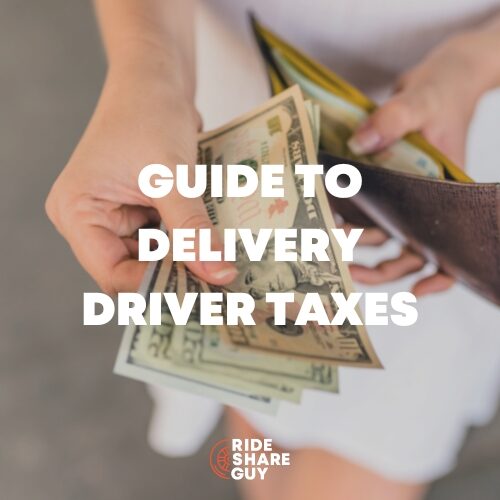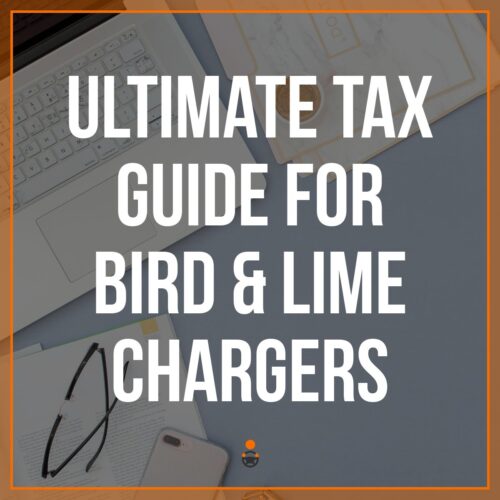Harry here. Uber and Lyft typically send out 1099s by January 31st, so hopefully you’ve been tracking all of your mileage! But if not, we’ve teamed up with Stride Tax for a guest post to help you figure out how you can still claim all those lost miles.
This post was written by Stride’s Tade Anzalone, who heads up their tax and finance support and is an Enrolled Agent with the IRS.

Your filing taxes and just realized you forgot to track your mileage
First of all, don’t panic! Many drivers have faced the same situation of not completely tracking their business miles or simply not knowing what to track. Sometimes new drivers don’t get the heads-up that their mileage is deductible. Often, drivers don’t keep a mileage log for all of the miles they’re allowed to deduct for theyear.
Fortunately, rideshare drivers are in a good place when it comes to finding extra evidence. Since Uber, Lyft, and other rideshare companies keep pretty thorough records of your activity, rideshare drivers have access to more corroborating evidence than most independent contractors.
Even though using an app to track miles throughout the entire year is absolutely the best way to document your mileage deduction, the good news is that drivers can piece together a mileage log based on incomplete records. (Stride Tax is the best tool for tracking miles and expenses for both rideshare and delivery drivers. Plus it’s 100% free!)
According to the IRS, this includes either a “written statement containing specific information about the element,” or “supporting evidence that is sufficient to establish the element.”
In plain English, this means that if you’re filling in the blanks on an incomplete mileage log, you need to make sure your estimate matches what evidence you do have.
Believe it or not, the IRS gives a few specific examples of how to put together a post-facto mileage log. One example is of a delivery driver backing up a mileage deduction with the invoices from their deliveries. The invoices would be classified as “circumstantial, rather than direct” evidence of business mileage. The same goes for other independent contractors like real estate agents, who can use a date book of client meetings to prove that they had to drive for business on certain days.
How to claim your lost miles
Luckily, as a rideshare or delivery driver you have some pretty detailed records of where you’re driving and for what reasons. These records can be used to fill in the other deductible business miles that weren’t recorded by your rideshare app.
For example, let’s assume you’re an Uber driver who started driving in March, but who hasn’t kept a mileage log for the first half of the year.
1) Start with your trip logs
Uber will track your on-trip mileage for you. This includes your mileage when you have a passenger in the car, but not your mileage when you are driving to the passenger, or driving between trips to find places where you’re likely to be matched with a passenger.
Your on-trip mileage serves as the minimum mileage that you can deduct. It’s not a complete record of the business miles that you actually drove, but it’ll still save you money at tax time.
2) Find your total mileage
When you claim your mileage deduction on a Schedule C (or in a tax filing software), you’ll likely need to input how many miles you drove in total during the year, including personal and commuting miles. You need to make sure your total mileage deduction makes sense when compared to your total miles driven. Ideally you’d note your odometer readings at the beginning and end of the year, but you could also use old maintenance receipts to figure your total mileage (since these often record odometer readings).
Once you find this number, you’ve got a range for what your actual deductible mileage is. You’ll know that your actual deductible mileage is somewhere between your total miles, and your rideshare miles.
Related article: Best mileage tracker apps for Uber and Lyft Drivers
3) Look for documentation of your other business mileage
Let’s assume that you are missing the miles from:
- Between trips
- When driving from home to where you picked up your first trip
- From your last trip back home
Here’s where the sleuthing starts. You’ll have to find evidence that proves you actually incurred this non-trip mileage while running your rideshare business. Here are a few ways you can find that evidence:
Calculate lost mileage for the drive to your first passenger
Let’s assume you go online with your Uber app as soon as you get in the car at home. You’ll need to calculate the mileage that you drive from your home, to your first passenger of the day.
On a given day you can see where you began your first trip or ended your last trip, and how far away it is from your home. It’s a tedious process, but if you calculate the mileage between those two points, and can document your exact starting and ending locations, you can calculate your deductible mileage from that information.
For example, if you go online with your Uber app at home in Oakland, but drive to San Francisco before you get your first passenger, you can calculate how many miles you drove to the city and include those in your deduction.
Calculate lost mileage between passengers
You also have records on where one trip ended, and where the next began. You can calculate the mileage that you incurred between dropping off one passenger and picking up another. Just be sure to include great notes on each drive that you add to your mileage log, and keep track of all of your supporting documents like Uber trip logs.
Want to double check your estimates?
Find recordings of your odometer readings throughout the year. This helps corroborate your story that your estimated mileage is consistent with your car’s total usage throughout the year. Maintenance receipts are great sources for odometer readings.
Find your driving patterns
The investigative work described above sounds like a hassle, right? Don’t worry, you can take the typical mileage you drive in a week or month and apply it to a larger sample of time.
If you find your total deductible mileage for one month, and can prove that you drove about the same amount each month, then you can apply your typical monthly mileage to the rest of the year.
For example, let’s say you were only tracking your Uber mileage for November and December of 2020. If you can show that your Uber income and trip number was the same for all 12 months of the year, and you know that you drove the same number of miles (or within a small range), then you could use your Uber income and trip logs as proof that your deductible mileage was consistent throughout the year.
One note: the goal of this exercise isn’t to re-create the mileage log that you should have kept in the first place. Unfortunately, it’s too late to have a complete mileage log of your business driving for the year, so don’t start making stuff up in order to have a complete log.
Rather, you’re looking to prove your average with as much evidence as you can. For rideshare drivers, you’ve got a lot of built-in evidence–after all, you didn’t receive paychecks from Uber for no reason. Just the fact that you received fare money from Uber proves that you did at least some driving. If you start with the evidence that you do have, you’ll be able to build a story around your rideshare activity.
4) Don’t let it happen again!
Take the headache out of finding your mileage next year by starting your tracking now. Stride Tax helps you track both your mileage and your deductible expenses (for all of your independent jobs).
Do you have any questions about mileage tracking? How are you tracking your mileage this year?
-Harry @ RSG
Read next:




